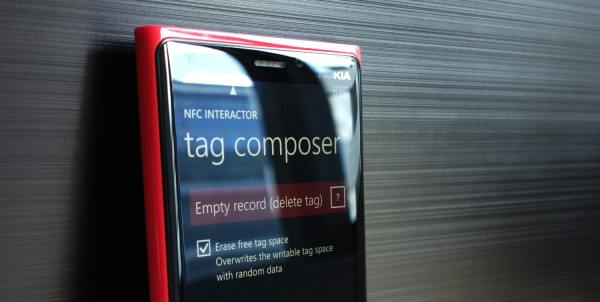Most NFC apps will simply write the so-called “Empty NDEF Record” to the tag when you choose to delete the tag. This writes the smallest possible standardized contents to the tag (only 3 bytes), and essentially makes the previous tag contents invisible as it tells the reader that the tag doesn’t have any further contents after those 3 bytes.
However, all the data that was not overwritten by the short 3 byte empty record will still remain in the writable NFC tag memory. With a low level NFC tag reading tool, you can scan the whole tag memory area and with that recover the previous tag contents.
This is comparable to deleting a file on your computer – the reference will be removed, but the actual data is still there and can be recovered – until it is overwritten with new data.
Secure Tag Erasing
 NFC interactor is the first app for Windows Phone that securely erases tags by overwriting the complete writable memory area. Instead of writing the minimum-sized 3 bytes message, NFC interactor will wait until the phone has discovered the real tag size.
NFC interactor is the first app for Windows Phone that securely erases tags by overwriting the complete writable memory area. Instead of writing the minimum-sized 3 bytes message, NFC interactor will wait until the phone has discovered the real tag size.
The app then creates the contents on the fly, filling the payload of the record with completely random data – with the exact size of the writable tag memory. With this approach, it will not be possible anymore to recover the previous tag contents.
To activate this unique feature, go to the “tag composer” and choose the “Empty record (delete tag)”. Now tick the optional checkbox to “Erase free tag space” and tap the button to write the tag.
Technical Details
Some details for NFC professionals: when erasing the tag, NFC interactor will write a record of type “Unknown” – by definition, an “Empty” record can’t contain any kind of payload and therefore can’t reach the size of the writable tag memory. “Unknown” records are usually also ignored by NFC devices, and can have an arbitrary size payload, which is random data in our case.
And of course, you’re free to overwrite the random tag contents with anything else afterwards – including the plain and simple “Empty” record.
